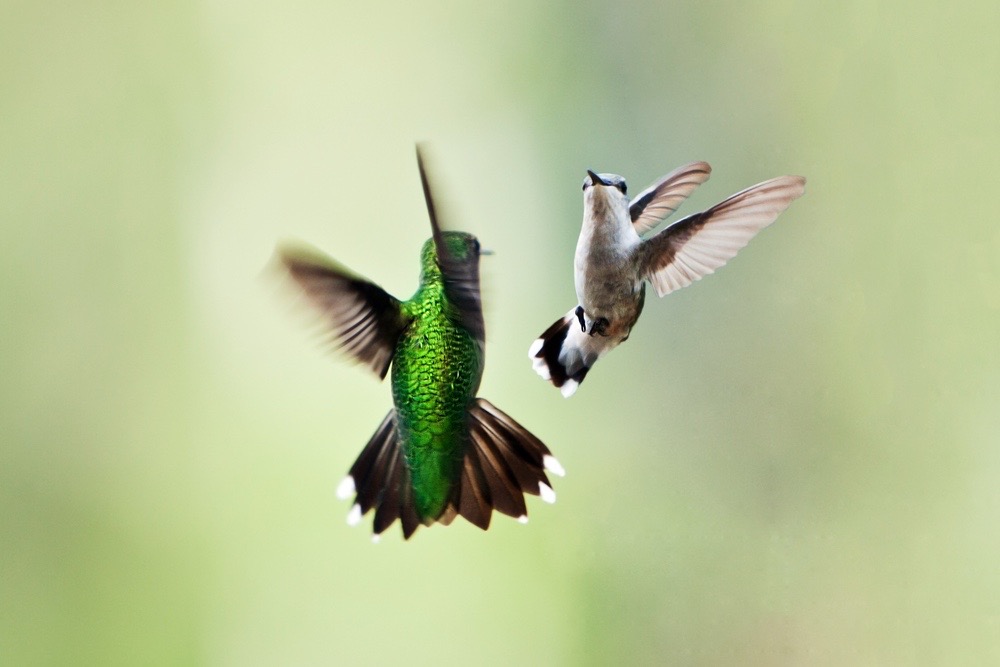Animal Sex: How Hummingbirds Do It

Endemic to the Americas, hummingbirds are defined by their small stature and dart-like movements. But when it comes to mating, do these aerial experts keep things equally quick or do they instead take the slow and steady approach?
Given hummingbirds' propensity to congregate around flowers and artificial feeders, one might expect that they're gregarious creatures, but this is far from the truth. In fact, hummingbirds are generally solitary, territorial birds, and most of the time they can be quite aggressive to one another, regardless of sex. "Hummingbirds are mean to everybody," said Kristiina Hurme, a behavioral ecologist at the University of Connecticut.
Related: Animal sex: How birds do it
Hummingbirds typically limit their social interactions to feeding and mating. The breeding season varies between species, but it often coincides with the rain, which causes a spike in the abundance of insects, said Alejandro Rico-Guevara, an ecologist and evolutionary biologist with the University of Connecticut and University of California-Berkeley. This rich source of protein is needed for plumage molting and egg production, as well as feeding chicks. [Photos of Hummingbirds from Around the World]
How hummingbirds go about mating also varies. "Every single species has a special ritual or mating display," Rico-Guevara told Live Science. "And they are super complicated."
Forest-dwelling hermit hummingbirds (those of the subfamily Phaethornithinae) often adhere to a so-called lek mating system, in which males gather in an open area to try to woo females, which visit the males one-by-one. The males, which maintain small territories, start by chirping. This sound is seemingly simple to human ears, but it actually contains layers of complexity when slowed down with computers. "[Hummingbirds] may not only be able to see in high speed but also listen in high speed," Rico-Guevara said.
An impressed female will perch near a singing male, prompting him to perform tricks to further entice her. These alluring moves may include making sounds with his bill, flying around the female, flying side-to-side in front of her, and displaying his tail and his feathers.
Get the world’s most fascinating discoveries delivered straight to your inbox.
Fights among competing males aren't uncommon. Many species have even evolved a kind of beak weaponry — serrated tips that resemble teeth — that aid them in these fights. During these battles, males will try to stab and bite each other, pluck off each other's feathers, and engage in a kind of aerial fencing, Rico-Guevara said.
But, Hurme added, it's not clear if these fights result in serious or fatal injuries because of the speed at which they occur and the fact that the fighting pair will often fly away.
Many other types of hummingbirds don't use a lek mating system. Instead, males will set up individual home ranges that they defend against other hummingbirds. In some cases, a male will leave his home range to find females, but more often than not it's the other way around, with a female wandering into a male's territory after hearing him sing, said Christopher Clark, a biologist at the University of California-Riverside.
When a female arrives, the male will display for her and show her how well he flies. A common move is called the shuttle display, in which the male will hover in front of his potential mate and slowly move side-to-side and up and down, Clark told Live Science.
One of the more spectacular displays is called the courtship dive, a move that only a small fraction of hummingbirds performs (those in the bee hummingbird clade). This dive involves flying high above the perched female and then quickly dive-bombing past her. When at the lowest point of the dive, the male will spread and close his tail feathers, allowing air to flow through them, which causes them to flutter and produce a sound.
"Each species has a unique tail shape with a unique sound," Clark said, adding that there's strong indirect evidence that the sounds are important to females, though it's unclear what type of tail chirps that females prefer most. It's also unknown which physical features (coloration and body size, for example) females find most attractive.
Once a female chooses a mate, she will allow him to climb onto her back; the male will then align his cloaca (waste and reproductive orifice) with hers and transfer sperm. It's a quick affair lasting just a matter of seconds.
Deed done, the pair will go their separate ways, Hurme said, adding that "the males provide no parental carewhatsoever."
Follow Joseph Castro on Twitter. Follow us @livescience, Facebook& Google+.

